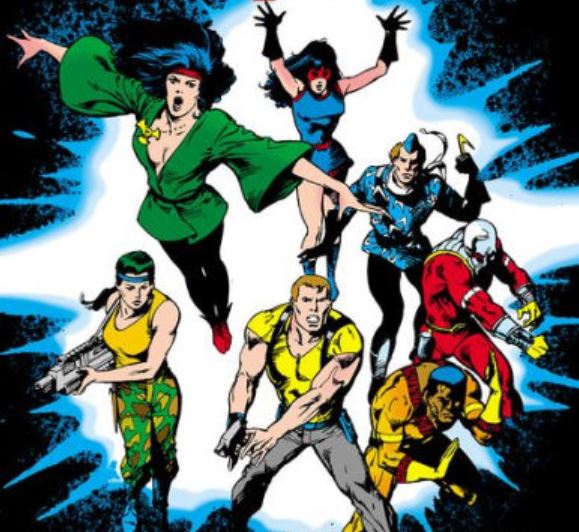
Happy New Year and welcome back to another installment of my Suicide Squad retrospective. If you’re new, you can start here. Basically, I’m excited for James Gunn’s The Suicide Squad coming out this April. To tide myself over until its release, I’ve decided to read Ostrander and McDonnell’s classic 1987 Suicide Squad run while giving you my thoughts on each issue. This month, I’ll be reading issues #9-#16 (Volume Two for you trade-paperback readers). If you’re as excited as I am, then I encourage you to read along and geek out with me. Issue #9 has a lot going on, so let’s jump right into it!
Suicide Squad #9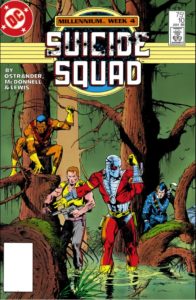
Last month, I mentioned how Rick Flag keeps Waller honest–a sort of check on her power. After the events of the last few issues, however, we’re starting to see the cracks form in Flag’s mental state. The result is an unchecked Waller who sends the Squad on a mission with complete disregard for their safety: They must plant a xyzedium bomb inside the Manhunter’s fortress, detonate it, then run like Hell. The problem? Only Waller and Flag know that there’s zero chance of escaping the blast radius. Surprisingly, Flag admits to Captain Atom that the Squad will perform better if they think there’s a chance of surviving. What follows is an action-packed, android espionage story of betrayal, redemption, and forgiveness.
Despite the crossover fluff, we still get those great character moments from before, like Boomerang calling Deadshot useless without his gimmicks. Even newcomers like Mark Shaw are given an interesting position in the story. A former Manhunter himself, Shaw is now seeking redemption as The Privateer. Of course, this brings about certain trust issues for Flag, who’s still salty from their last encounter. That being said, it was fun to see the two forced into working together as the last ones standing. However, it’s Dr. Karin Grace who ends up being the final nail in the coffin for the Manhunters. Taking the bomb-car hybrid herself, she rams it Grand Theft Auto-style through an army of Manhunters before telling them to go to Hell. Not a bad send off by Suicide Squad standards.
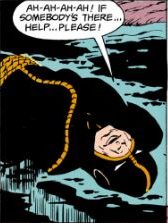 But of course, I can’t leave this issue without mentioning everyone’s favorite supervillain, Slipknot. Yes, this is the infamous issue where the team finally witnesses one of the bombs placed around their arms explode. Unfortunately for Slipknot, only Boomerang notices his misfortune; everyone else is too busy to remember that they brought along a rope guy. But even more hilarious is right after the explosion, when Flag disables everyone’s armbands as a safety measure. Also, Slipknot isn’t even dead! He’s simply lost an arm which, being the go-to rope guy, is sort of like Green Arrow having to use his bow with one hand. But this isn’t Green Arrow, and losing an arm is a fate worse than death for our resident rope and knots expert.
But of course, I can’t leave this issue without mentioning everyone’s favorite supervillain, Slipknot. Yes, this is the infamous issue where the team finally witnesses one of the bombs placed around their arms explode. Unfortunately for Slipknot, only Boomerang notices his misfortune; everyone else is too busy to remember that they brought along a rope guy. But even more hilarious is right after the explosion, when Flag disables everyone’s armbands as a safety measure. Also, Slipknot isn’t even dead! He’s simply lost an arm which, being the go-to rope guy, is sort of like Green Arrow having to use his bow with one hand. But this isn’t Green Arrow, and losing an arm is a fate worse than death for our resident rope and knots expert.
If you want more (two-armed) Slipknot moments, check out The Fury of Firestorm #64 (1987). In it, our titular villain tries to … choke Firestorm into submission with an expertly tied noose? As you can imagine, Firestorm’s story doesn’t end with Slipknot, but it’s funny nonetheless. Poor guy can’t catch a break.
Suicide Squad #10
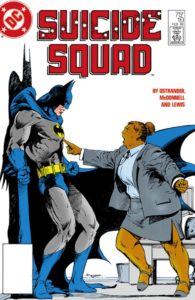
After the Manhunter shenanigans from last issue, we’re introduced to Reverend Craemer, Belle Reve’s newest addition. What I enjoyed about this issue is the time we spend with the Belle Reve staff. Learning that Reverend Craemer prefers to live at the prison, as opposed to leaving every night like the others, reinforces how crappy the job is. This makes it more believable that Reverend Craemer truly wants to make an impact, preferring to walk among sinners instead of preaching from afar. Hearing from the staff themselves on how bad the conditions are makes Belle Reve feel like a lived-in part of the DC Universe canon.
Speaking of non-Squad members, we have a guest appearance from the Dark Knight himself. Waller and Batman’s rivalry is a storied one. We see it portrayed in the fantastic Justice League Unlimited (2004) animated series, and briefly in the Suicide Squad (2016) film. But seeing its origin here better puts their relationship into perspective. Waller respects Batman as a threat, and watching him breeze through inmates and guards reinforces that thought. However, Batman being a credible threat is the least surprising thing this issue. Instead, it’s watching Waller intimidate The Dark Knight into backing down himself. At this early point in the Squad’s history, standing up to Batman might just be one of The Wall’s most character-defining moments. Even Deadshot is amused by this. The only one not amused? Rick Flag, whose admiration of The Dark Detective seems to have propelled him back to being team leader.
The Doom Patrol and Suicide Squad Special #1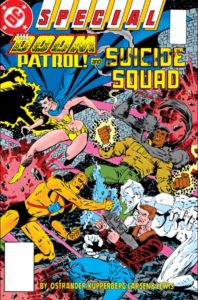
While mainstays like Deadshot and Boomerang have earned plot armor immunity among the Squad, this issue features an entirely new cast of villains ripe for exploitation. Characters like The Thinker and Weasel are even appearing in the newest film, possibly hinting at their eventual live-action fates. In any case, we’ve got an oversized team-up issue, completely new Squad members, and tons of political intrigue, so you just know things are going to get messy. And hey, it’s the Suicide Squad. Did you expect anything less?
Ostrander’s Suicide Squad often reflects the fears that Americans had at the time it was published. So far, we’ve seen the Squad fight against Jihadi terrorists and venture deep into the frozen heart of the Soviet Union. Here, the Squad is dropped into the middle of the Nicaraguan Revolution and, though never directly mentioned, the Iran-Contra Affair. There’s even a reference to Eugene Hasenfus. But instead of an ex-Marine that needs 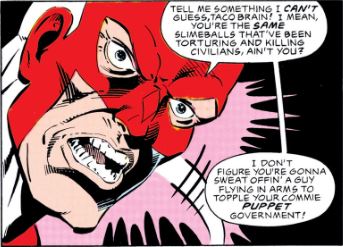 saving this time around, it’s the vigilante known as Hawk. Grizzled, casually racist, and with references to, “Commies making a mess out of the USA’s backyard,” Hawk is a caricature of the typical red-blooded American during that time. However, it’s the new cast of villains and the The Doom Patrol that provide the most fun this issue.
saving this time around, it’s the vigilante known as Hawk. Grizzled, casually racist, and with references to, “Commies making a mess out of the USA’s backyard,” Hawk is a caricature of the typical red-blooded American during that time. However, it’s the new cast of villains and the The Doom Patrol that provide the most fun this issue.
Behind the political posturing that lands all three teams in Nicaragua together, there’s a clear anti-war sentiment on display here. The Doom Patrol, Suicide Squad, and even Rocket Reds are mere pawns, duped into a war they have no business being in. Some, sadly, lose their lives because of this. Psi’s death is particularly poignant and watching Tempest put aside his differences with Mr. 104 are both great moments. Flag using The Thinker’s “Thinking Cap” is also a fun surprise, and the resolution to its use was satisfying. It answered the question of why someone like Flag doesn’t just use the Thinking Cap forever since it appears to be insanely powerful. The answer in a nutshell? Absolute power corrupts absolutely. However, the best character moments happens with the ones I know little about, which speaks to how well-crafted this issue turned out to be.
Suicide Squad #11-#12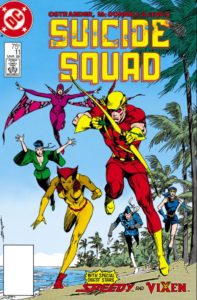
Speedy and Vixen are recruited to help dismantle a Colombian drug operation and kill its leader, Xavier Cujo. Both characters are surprising additions to the team but are given compelling reasons to help. Mari McCabe, the retired heroine Vixen, is seeking revenge against Cujo for gunning down her colleagues. But will this be the catalyst that causes her to succumb to the Tantu Totem? Speedy, on the other hand, has a history with drug addiction, first revealed back in Green Lantern #85 (1971). This isn’t immediately evident to those unfamiliar, but his dour demeanor hints that this mission hits close to home for him.
The two heroes gel surprisingly well with the rest of the team. A former member of the now disbanded Justice League of America, Mari McCabe is at a sort of midlife crisis by the end of Issue #12. This, of course, makes her the perfect candidate to join the Squad full-time. Speedy, on the other hand, doesn’t say much, but he has a rather poignant talk with Nightshade. Their conversation begins awkwardly but ends on common ground over the decisions they’ve made in the name of duty—especially the ones that they regret. It’s a brief discussion but a nice reminder that both are soldiers who have gone through their own trials and tribulations that have brought them to the Squad.
This story arc isn’t all doom and gloom, though, thanks to some well-placed comedic relief. Specifically, the return of Digger Harkness, a.k.a. Captain Boomerang (Or Boomerbutt, as Waller so eloquently calls him), brings a lot of humor to a relatively serious story. In fact, this story arc includes some of the best Boomerang gags so far. However, the funniest scene goes to Briscoe, the Squad’s auxiliary member who turns down June Moone’s advances in favor of sleeping in his favorite helicopter, Sheba. The story ends on a rather sardonic note, however. Even if used recreationally and without addiction, is the price of drugs truly worth it?
Suicide Squad #13
Against the wishes of Waller, Rick Flag gathers the Squad to retrieve Tom Tresser, aka Nemesis, who has been quite literally rotting in a Russian gulag since his capture in Suicide Squad #7. And while defying Waller may seem like suicide (no pun intended), the retrieval of Nemesis is quite personal for Flag. But The Wall isn’t one to be so easily played for a fool. Pulling some strings, she enlists the help of the Justice League International to bring back her team safely and quietly. Much of this setup is in Justice League International #13, and while not necessary reading, it’s still worth checking out.
Between the two crossover issues, there’s lots of satisfying callbacks to previous Squad adventures. One favorite of mine was seeing Batman mock Deadshot for missing in Suicide Squad #10. But behind the action and humor, there’s a really heartfelt moment between Vixen and J’onn J’onzz. He reminds her that the remorse she feels over killing Cujo sets her apart from the Squad’s most villainous members. If anything, it’s a reminder of the kind of person she truly is, and a hero whom he relied on heavily during her time with the JLA. J’onn is typically referred to as the glue that holds the various Justice Leagues together, and seeing Ostrander write him as basically the DCU’s loving grandfather makes me want to dive into his 1998 Martian Manhunter series.
Suicide Squad #14-#16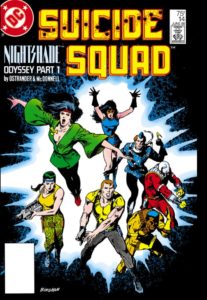
As a concept, the Suicide Squad has been compared to gritty, action-packed war movies like The Dirty Dozen (1967). Supernatural characters like Nightshade and The Enchantress, however, add a wrinkle to the genre. We saw June Moone visit Madame Xanadu in issue #8, but this Nightshade Odyssey story arc offers some follow up. Poised to make good on Waller’s promise to help Eve Eden save her brother from the Nightshade Dimension, Bronze Tiger gathers what remains of the Squad after their fiasco with the JLI.
What I enjoy the most from Nightshade Odyssey is the jarring tonal shifts. This would normally be a problem, but Ostrander and McDonnell have proven themselves capable of balancing humor with gravitas. In one scene, Boomerang hilariously outdrinks himself into being strung along on the mission. But immediately after, we get June Moone’s chilling, “It’s going home” monologue. The tonal shift works because each scene works on its own merits. In particular, June’s terror feels incredibly palpable because she’s terrified to even say The Enchantress’s name in her own head. It creates an uneasy sense of dread over discovering who, exactly, The Enchantress is.

When we enter the Nightshade Dimension, it’s as weird and confusing as you can imagine. It’s clear McDonnell and the art team had a blast creating an unfamiliar environment for our protagonists–from twisted tree trunks, acidic blood rain that eats at clothing, to shrieking faces permanently carved onto pillars. Sadly, this doesn’t last long, as the rest of the arc feels like it slowly deflates with exposition. The third part of Nightshade Odyssey doesn’t even include Nightshade, but instead becomes a much less interesting Shade, the Changing Man story. There’s still some great gags, and watching The Enchantress let loose makes the story arc feel worth it. However, this probably won’t be high up on my list of favorite Squad missions.
That’s it! Check back here for volume three, which collects Suicide Squad #17-25 and the series’ first annual issue.

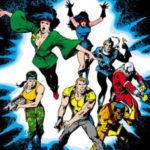


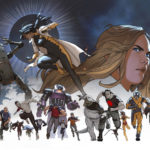
2 thoughts on “[RETROSPECTIVE] ‘SUICIDE SQUAD’ (1987) #9-#16”